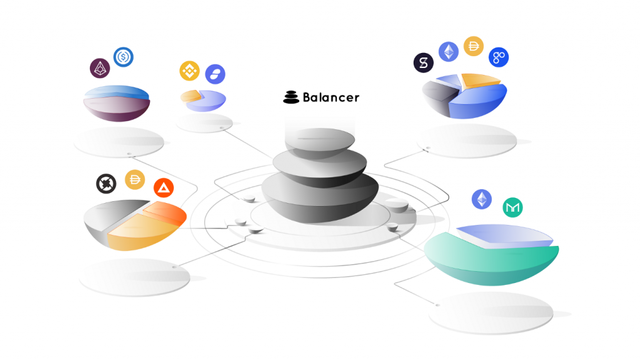What is BAL?
BAL is the governance token for the Balancer Protocol. It can be used to vote on proposals and steer the direction of the protocol.
The total supply of BAL is capped at 100 million tokens, 25 million of which is allocated to the founding members, core developers, advisers, and investors. The rest are being distributed to the community through liquidity mining.
What is Balancer?
Balancer is a multi-token automated market maker (AMM) that functions as a self-balancing weighted portfolio protocol. Balancer is built on the Ethereum network. It allows anyone to create or add liquidity to customizable pools and earn trading fees. Compared to a typical constant product AMM model, Balancer uses a generalization formula that could be adjusted to any number of tokens at any amount of weightage.
It mimics the concept of an index fund where assets are regularly being reallocated based on the price and returns of the assets. Index fund is a common financial instrument that helps investors to achieve risk diversification by maintaining a controlled risk exposure to a portfolio. Rather than paying a portfolio manager to actively or programmatically manage users' funds, Balancer helps solve a similar problem with smart contracts.
How is the Balancer Protocol useful?
There are two types of users that can benefit from using Balancer: liquidity providers and traders. Liquidity providers are the ones who own Balancer pools or participate in shared pools. Traders are the users that buy and sell ERC-20 tokens on the open market.
Liquidity providers can have a controlled exposure to different crypto assets without costly and complicated rebalancing. At the same time, liquidity providers can earn passive income by utilizing the ERC-20 tokens that are sitting idle in their wallets.
Traders can exchange tokens, have access to a diverse set of pools, and seek profit by arbitraging price differences on Balancer with other exchanges.
How does Balancer work?
The fundamental building block of the Balancer Protocol is the Balancer Pool. Balancer Pool can be viewed as an automated, market-making portfolio. Each token asset has an independent weight, and can be traded against other tokens in the pool. For example, you could have a pool with three tokens in the following proportions: 50% DAI, 25% SUSHI, and 25% WETH.
The concept of a Balancer pool is to keep the value function of the pool’s weights and balances to a constant. If the relative prices of the tokens change, the pool as a whole is continuously rebalanced to maintain each token's proportion of the total value.
Each trade that occurs in a Balancer Pool generates a fee for the pool owner. The fee is a percentage of the trading volume and is adjustable by the pool owner when the pool is created.
Balancer has a few pools available:
Private Pools - Private pools are completely controlled by the owner. Only the owner can contribute liquidity and has full permissions over the parameters of the pool.
Shared Pools - Creators of shared pools only have one opportunity to permanently set the pool parameters including number of tokens, weightage, and trading fees. The creator doesn’t have any special privileges over the shared pool and anyone may contribute liquidity to the pool. The ownership of the pool’s liquidity is tracked by a specific token called the Balancer Pool Token (BPT).
Smart Pools - Smart pools are a variation of private pools where the controller is a smart contract, enabling arbitrary logic to determine how parameters can be adjusted. Anyone may contribute liquidity to a smart pool and asset ownership is tracked by BPT.
